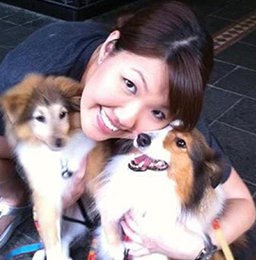Growling is Simply Communication
Up For Paws Contributors
By: Maureen Tay
Let me tell you about Sandy (not her real name), one of my clients. I received a call from her and she told me that her mixed breed medium sized dog, Coco, suddenly attacked one of her friends while he was over at her place. He was trying to pet her, she told me. I proceeded to ask all kinds of questions.
Do you often have friends over? Not all the time.
Had this happened before? No. But she never really bit anybody.
Is Coco a very sociable dog? Not really.
What did she do in the past when other people tried to touch her? Oh, she would growl and show her teeth when they moved towards her.
What did you do when she growled? Well, I would smack her and grab her collar, tell her no and then leash her up.
So every time she growled, you would correct her? Yes. I did, and it worked because she stopped!
That was what I was afraid of. The growling stopped. That’s not a good sign. Why would I say that? Let me run through how dog trainers like myself assess and understand dogs.
- Dogs can’t speak. They can’t tell you what they are feeling and why they do things they do.
- We rely on their body language and the signs they exhibit to tell us how they are feeling.
Sandy is not my first client to have faced such a problem. Many dog owners misinterpret growling for aggression and correct their dog for doing so. There are plenty of examples at dog parks, for instance you may see a rebellious young dog persistently asking another dog to play with him. The other dog initially ignores the dog. However, the young dog relentlessly continues to jump on the other dog in attempts to get his attention. This time, the dog turns and growls at the first dog. The young pup ignores the warning signs and the older dog growls even louder. The owner of the older dog now runs over and corrects him for the “offensive” behaviour before dragging him away and out of the park as a punishment.
“Always remember, growling is simply communication.”
The older dog has in fact done nothing wrong! Growling is a canine warning and is perfectly acceptable in dog behaviour. It actually means (in human definition) “I don’t like that” or “Don’t come closer” or “Stop it!”. In this situation, the owner of the young dog should have stepped in and taken his dog away.
It is instilled in humans to translate growling for a threat. A growl does in fact sound scary and it’s normal that we would get upset over it. But I am going to say this – a growl is actually a GOOD thing! Of course it is NOT good for the dog to growl all of the time (that would be classified under severe behaviour issues) but it is in fact a an excellent non-aggressive form of communication that dogs engage in. The growl is there for us to understand that the dog is not comfortable with the situation, and that we should either retreat from that situation or remove the dog from it. This prevents us from getting bitten. It is there as a warning.
Whether a dog growls at something or someone, it is a warning (“excuse me, please stop it”). If a dog wanted to attack, he would have. Growling is in fact used to prevent aggression, and not to start it. However, should dog owners punish their dogs for growling (like Sandy), then the dog learns over time that growling leads to punishment, and they would stop it altogether. Once this early warning system has been removed, the dog will now go straight for a bite.
Tips for handling growling:
Should your dog or someone else’s start growling at you, the best way to defuse the situation is to glance downwards and to the side (no eye contact with the dog as it is considered a threat) and back away slowly.
Keep the dog in your peripheral vision just to be safe. Do not turn your back on the dog as some dogs may be prone to attacking from the back.
If the dog in question is yours, contact a professional dog trainer so as to address the problem.
Always remember, growling is simply communication.
==
Maureen Tay is a positive dog trainer and dog expert, and a regular Up For Paws Blog contributor. Maureen is the owner and head trainer of KasPup UniFURsity a licensed Singapore-based dog training school that believes in positive reinforcement training methods. Maureen is one of the pioneers of clicker training and positive reinforcement dog training in Singapore, and has more than 7 years of dog training experience under her belt. She is also the Chief handler and trainer of DM Therapy SG where she works together with a psychologist to conduct Animal Assisted Therapy for children with autism, down syndrome and ADHD, while using her trained shetland sheepdogs as therapy dogs. She is no stranger to frequent voluntary work with local animal shelters such as Save Our Street Dogs SOSD and organizations such as Mutts and Mittens, where she uses clicker training and force free methods to help rehome dogs.
Maureen Tay can be contacted at kaspup.unifursity@gmail.com.
